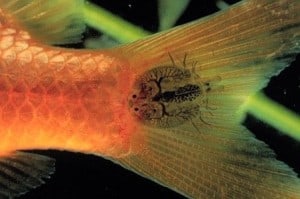Usually from fish that were living in an outdoor pond at one time and bringing them into an indoor aquarium. Also, fish lice can be introduced from wild fish that are added to an aquarium. Lice travel from one host fish to another, spreading bacteria and viruses, so once they’re in your aquarium, you must get rid of them.
 Symptoms:
Symptoms:
- Red spots on fish indicating an inflammation
- Fish are aggravated and restless
- Usually fish will rub skin against aquarium glass or other objects in an effort to remove lice
- Other telltale signs: Lice have eight legs—and resemble tiny pale crabs. They appear as flat, dark oval dots crawling on fish
- Lice use suckers to attach to fish before piercing the skin to feed on the host
Treatment:
Common methods include physically removing the parasite and cleaning the wound with an antiseptic like iodine. Also common is bathing freshwater fish in a seawater bath (35ppt) for about 5 minutes for multiple days until the parasite falls off, or using a formalin bath.
Prevention:
Always ensure, especially if buying wild caught fish, that you quarantine the fish before introducing them to the main aquarium by means of putting them in a hospital/quarentine tank for 3-4 weeks after taking delivery.
Tropical Fish Site takes no responsibility for diagnosing the exact problem with your tropical fish, this is purely meant as a guide only. Be sure to look at other common tropical fish diseases to ensure you have made the correct diagnosis as there is often crossover between them.
API AQUARIUM SALT Freshwater Aquarium Salt 453-Gram Box
Features:- Contains one (1) API AQUARIUM SALT Freshwater Aquarium Salt 453-Gram Box
- Promotes fish health and disease recovery with increased electrolytes
- Improves respiration for fish in freshwater aquariums
- Made from evaporated sea water for all-natural results
- Use when changing water, when setting up a new freshwater aquarium and when treating fish disease
API 800 Test Freshwater Aquarium Water Master Test Kit
Features:- Contains one (1) API Freshwater master kit 800, including 7 bottles of testing solutions, 1 colour card and 4 glass tubes with cap
- Helps monitor water quality and prevent invisible water problems that can be harmful to fish and cause fish loss
- Accurately monitors five most vital water parameters levels in freshwater aquariums: pH, High Range PH, Ammonia, Nitrite and Nitrate
- Designed for use in freshwater aquariums only
- Use for weekly monitoring and when water or fish problems appear




Related Posts
A Deeper Look In To Loach Fish Species
How Much Salt Should I Add To My Freshwater Aquarium
Everything You Need To Know About Using T5 Lights For Your Aquarium